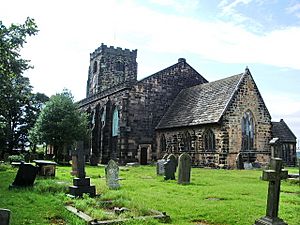St Andrew's Church, Leyland facts for kids
Quick facts for kids St Andrew's, Leyland |
|
|---|---|

Parish Church of St Andrews
|
|
| Lua error in Module:Location_map at line 420: attempt to index field 'wikibase' (a nil value). | |
| OS grid reference | SD 54111 21591 |
| Location | Leyland, Lancashire |
| Country | England |
| Denomination | Church of England |
| Churchmanship | Conservative Evangelical |
| History | |
| Status | Parish church |
| Architecture | |
| Functional status | Active |
| Heritage designation | Grade II* |
| Designated | 26 July 1951 |
| Administration | |
| Deanery | Leyland |
| Archdeaconry | Blackburn |
| Diocese | Blackburn |
| Province | York |
St Andrew's Church is an important Anglican church in Leyland, England. It is an active parish church within the Church of England. This means it serves the local community for worship and other activities. The church is officially recognized as a Grade II* listed building, which highlights its special historical and architectural importance.
Contents
History of St Andrew's Church
The area around Leyland used to be a very large church district. It included many smaller areas like Euxton and Clayton-le-Woods. It is believed that a Norman church, built by the Normans who came to England in 1066, stood on this spot a long time ago.
In the 12th century, a powerful baron named Warine Bussel gave the church to Evesham Abbey, a monastery far away in Worcestershire. From the 14th century onwards, the abbey was responsible for choosing the priests for Leyland church. After the Dissolution of the Monasteries in the 16th century, when King Henry VIII closed down monasteries, the right to choose the priest for St Andrew's was given to John Fleetwood.
The oldest part of the current church is the chancel, which was built in the 14th century. The church tower was likely added later, around the late 15th or early 16th century. The main part of the church, called the nave, was rebuilt between 1816 and 1817. Later, in 1874, the church was carefully repaired and updated by a famous architecture firm called Paley and Austin. The roof of the nave was replaced between 1951 and 1953, and the chancel roof was replaced in 1956.
St Andrew's Today
St Andrew's was officially named a Grade II* listed building on July 26, 1951. This means it is a very important historical building. Today, St Andrew's is still a busy Church of England parish church. It is part of the Diocese of Blackburn and the Province of York, which are larger church areas. The church follows a certain tradition within the Church of England.
Architecture of St Andrew's
St Andrew's Church is built from stone, and its roofs are made of stone slate and copper. The church has a main body (the nave), a square tower at the west end, and a chancel at the east end. There is also a small room called a vestry north of the chancel.
Outside the Church
The tower has a crenellated top, which looks like the top of a castle wall. It also has strong supports called buttresses at its corners. There are clocks on three sides of the tower. You can also see arched openings with louvres (slanted slats) where the church bells are.
The nave, the main part of the church, is built in the Gothic style. It also has a crenellated parapet (a low wall at the edge of the roof) and a copper roof. There are five windows on both the north and south sides of the nave. These windows are arched and have decorative stone patterns called tracery. The chancel is smaller and lower than the nave. Its windows are also arched with tracery. The large east window has three sections under a pointed arch.
Inside the Church
The inside of the tower is about 16 feet 6 inches (about 5 meters) square. The floor of the tower is a bit lower than the nave, and there are five steps leading up to the main church area. The nave itself is quite large, measuring about 73 feet (22 meters) long and 52 feet 6 inches (16 meters) wide. There are three galleries inside, which are like balconies. In the southeast corner, there is a small chapel.
The chancel, where the altar is, measures about 39 feet 3 inches (12 meters) long and 18 feet 4 inches (5.6 meters) wide. You enter it from the nave through a decorative arch. In the south wall of the chancel, there are three special seats called sedilia under semi-circular arches. Next to these seats is a piscina, which is a basin used for washing sacred vessels.
The church has beautiful Stained glass windows, some made by famous artists like Harry Stammers. There are also old monuments from the 18th and 19th centuries. The Faringdon Chapel inside the nave has brass plaques from the 19th century.
Outside the Church Grounds
East of the chancel, there is a small building from the early 19th century. It was used as a watch house and a hearse house. It is made of smooth stone and has a slate roof. The churchyard also contains the war graves of 15 soldiers from World War I and three from World War II.
See also
- Grade II* listed buildings in Lancashire
- Listed buildings in Leyland, Lancashire
- List of ecclesiastical works by Paley and Austin

